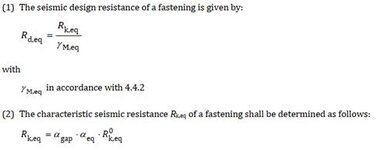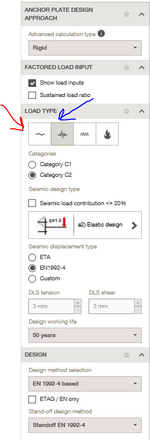Hello everyone,
My question is related to the Design of fastenings under seismic actions according to Eurocode 1992-4:2018 (Clause 9 and Annex C of standard).
This Clause provides requirements for the design of post-installed fasteners and cast-in headed fasteners used to transmit seismic actions.
We model the structure in some of the 3D calculation software (Robot Analysis, SAP2000,...), apply the loads, do a multimodal analysis of the structure, do a calculation (adopt seismicity zone, soil parameters, behavior factor etc.), create load combinations. Forces that we get from this seismic combination according to Eurocode:

represent the input forces for Anchor design (PROFIS, Idea Statica, etc.) that we apply to act on the connection node.
According to Annex C, part C.5 of EC 1992-4:2018, seismic design fastening resistance is given by:

where every anchor resistance is reduced with coefficients α that are ≤ 1.
Now, I'm trying to understand Eurocode better. Steel structures are often designed with a behavior factor of q = 1.5 and this belongs to Low dissipative structural DCL behavior, but does this mean that the anchors can be calculated for the forces from the seismic load combination, in the same way as the calculation for forces from STR/GEO load combination, or does this reduction in anchor bearing capacity have to be taken into account? Or is this in Annex C something that refers to some special requirements for the ductility of the structure and we should not deal with this reduction of anchor capacity if we use forces from the EC seismic load combination?
For example, I have calculated the steel structure with behavior factor q=1.5 and now I'm looking for the forces in node from seismic load combination: G (dead load)+0.3Q (live load)+Ex+0.3E, and for example I have axial force N=100kN (tension) and shear force T=200kN.
Do I input these forces as a permanent/ quasi-permanent load or as a seismic load in Profis Anchor HILTI software (red or blue arrow):

If the blue option (seismic design) is selected, software will reduce the bearing capacity of anchors according to Annex C formulas.
I am confused by the fact that if we have adopted a low-ductility structure with low behavior factor, do we deal with this seismic anchor calculation that ensures the ductility of the nodes in the seismic combination? Maybe I miss the point and I don't understand Eurocode very well, that's why I'm asking here.
Thanks in advance for your help
My question is related to the Design of fastenings under seismic actions according to Eurocode 1992-4:2018 (Clause 9 and Annex C of standard).
This Clause provides requirements for the design of post-installed fasteners and cast-in headed fasteners used to transmit seismic actions.
We model the structure in some of the 3D calculation software (Robot Analysis, SAP2000,...), apply the loads, do a multimodal analysis of the structure, do a calculation (adopt seismicity zone, soil parameters, behavior factor etc.), create load combinations. Forces that we get from this seismic combination according to Eurocode:

represent the input forces for Anchor design (PROFIS, Idea Statica, etc.) that we apply to act on the connection node.
According to Annex C, part C.5 of EC 1992-4:2018, seismic design fastening resistance is given by:

where every anchor resistance is reduced with coefficients α that are ≤ 1.
Now, I'm trying to understand Eurocode better. Steel structures are often designed with a behavior factor of q = 1.5 and this belongs to Low dissipative structural DCL behavior, but does this mean that the anchors can be calculated for the forces from the seismic load combination, in the same way as the calculation for forces from STR/GEO load combination, or does this reduction in anchor bearing capacity have to be taken into account? Or is this in Annex C something that refers to some special requirements for the ductility of the structure and we should not deal with this reduction of anchor capacity if we use forces from the EC seismic load combination?
For example, I have calculated the steel structure with behavior factor q=1.5 and now I'm looking for the forces in node from seismic load combination: G (dead load)+0.3Q (live load)+Ex+0.3E, and for example I have axial force N=100kN (tension) and shear force T=200kN.
Do I input these forces as a permanent/ quasi-permanent load or as a seismic load in Profis Anchor HILTI software (red or blue arrow):

If the blue option (seismic design) is selected, software will reduce the bearing capacity of anchors according to Annex C formulas.
I am confused by the fact that if we have adopted a low-ductility structure with low behavior factor, do we deal with this seismic anchor calculation that ensures the ductility of the nodes in the seismic combination? Maybe I miss the point and I don't understand Eurocode very well, that's why I'm asking here.
Thanks in advance for your help
